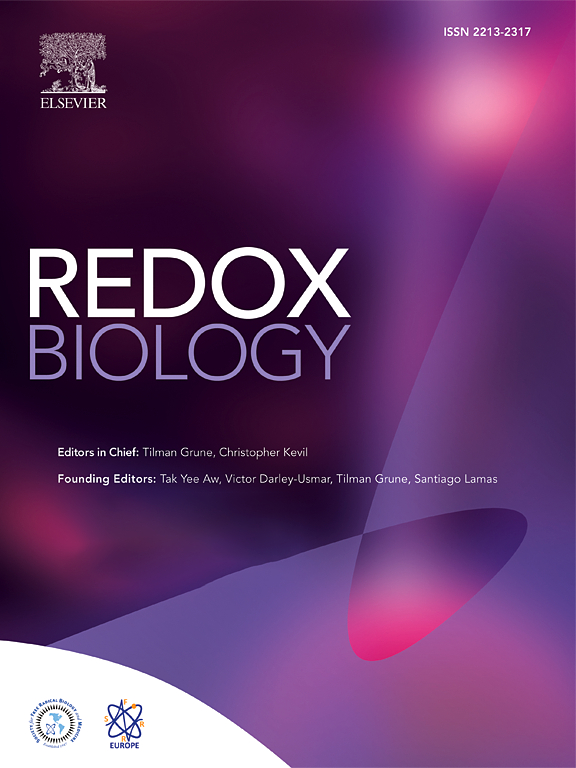Isoliquiritigenin alleviates cerebral ischemia-reperfusion injury by reducing oxidative stress and ameliorating mitochondrial dysfunction via activating the Nrf2 pathway
IF 10.7
1区 生物学
Q1 BIOCHEMISTRY & MOLECULAR BIOLOGY
引用次数: 0
Abstract
Cerebral ischemia-reperfusion injury (CIRI) refers to a secondary brain injury that occurs when blood supply is restored to ischemic brain tissue and is one of the leading causes of adult disability and mortality. Multiple pathological mechanisms are involved in the progression of CIRI, including neuronal oxidative stress and mitochondrial dysfunction. Isoliquiritigenin (ISL) has been preliminarily reported to have potential neuroprotective effects on rats subjected to cerebral ischemic insult. However, the protective mechanisms of ISL have not been elucidated. This study aims to further investigate the effects of ISL-mediated neuroprotection and elucidate the underlying molecular mechanism. The findings indicate that ISL treatment significantly alleviated middle cerebral artery occlusion (MCAO)-induced cerebral infarction, neurological deficits, histopathological damage, and neuronal apoptosis in mice. In vitro, ISL effectively mitigated the reduction of cell viability, Na+-K+-ATPase, and MnSOD activities, as well as the degree of DNA damage induced by oxygen-glucose deprivation (OGD) injury in PC12 cells. Mechanistic studies revealed that administration of ISL evidently improved redox homeostasis and restored mitochondrial function via inhibiting oxidative stress injury and ameliorating mitochondrial biogenesis, mitochondrial fusion-fission balance, and mitophagy. Moreover, ISL facilitated the dissociation of Keap1/Nrf2, enhanced the nuclear transfer of Nrf2, and promoted the binding activity of Nrf2 with ARE. Finally, ISL obviously inhibited neuronal apoptosis by activating the Nrf2 pathway and ameliorating mitochondrial dysfunction in mice. Nevertheless, Nrf2 inhibitor brusatol reversed the mitochondrial protective properties and anti-apoptotic effects of ISL both in vivo and in vitro. Overall, our findings revealed that ISL exhibited a profound neuroprotective effect on mice following CIRI insult by reducing oxidative stress and ameliorating mitochondrial dysfunction, which was closely related to the activation of the Nrf2 pathway.
异桔梗甙元通过激活Nrf2途径减少氧化应激和改善线粒体功能障碍,从而减轻脑缺血再灌注损伤。
脑缺血再灌注损伤(CIRI)是指缺血脑组织恢复供血后发生的继发性脑损伤,是导致成人残疾和死亡的主要原因之一。多种病理机制参与了 CIRI 的进展,包括神经元氧化应激和线粒体功能障碍。据初步报道,Isoliquiritigenin(ISL)对脑缺血损伤的大鼠具有潜在的神经保护作用。然而,ISL 的保护机制尚未阐明。本研究旨在进一步研究 ISL 介导的神经保护作用,并阐明其潜在的分子机制。研究结果表明,ISL能明显减轻大脑中动脉闭塞(MCAO)诱导的小鼠脑梗死、神经功能缺损、组织病理学损伤和神经细胞凋亡。在体外,ISL能有效缓解PC12细胞因氧-葡萄糖剥夺(OGD)损伤引起的细胞活力、Na+-K+-ATP酶和MnSOD活性的降低以及DNA损伤程度。机理研究发现,服用 ISL 能明显改善氧化还原平衡,通过抑制氧化应激损伤、改善线粒体生物生成、线粒体融合-裂变平衡和有丝分裂来恢复线粒体功能。此外,ISL 还能促进 Keap1/Nrf2 的解离,增强 Nrf2 的核转移,促进 Nrf2 与 ARE 的结合活性。最后,ISL通过激活Nrf2通路和改善小鼠线粒体功能障碍,明显抑制了神经元凋亡。然而,Nrf2抑制剂brusatol逆转了ISL在体内和体外的线粒体保护特性和抗凋亡作用。总之,我们的研究结果表明,ISL通过降低氧化应激和改善线粒体功能障碍,对CIRI损伤后的小鼠具有深远的神经保护作用,这与Nrf2通路的激活密切相关。
本文章由计算机程序翻译,如有差异,请以英文原文为准。
求助全文
约1分钟内获得全文
求助全文
来源期刊

Redox Biology
BIOCHEMISTRY & MOLECULAR BIOLOGY-
CiteScore
19.90
自引率
3.50%
发文量
318
审稿时长
25 days
期刊介绍:
Redox Biology is the official journal of the Society for Redox Biology and Medicine and the Society for Free Radical Research-Europe. It is also affiliated with the International Society for Free Radical Research (SFRRI). This journal serves as a platform for publishing pioneering research, innovative methods, and comprehensive review articles in the field of redox biology, encompassing both health and disease.
Redox Biology welcomes various forms of contributions, including research articles (short or full communications), methods, mini-reviews, and commentaries. Through its diverse range of published content, Redox Biology aims to foster advancements and insights in the understanding of redox biology and its implications.
文献相关原料
公司名称
产品信息
上海源叶
Isoliquiritigenin
|
≥98.0%
 求助内容:
求助内容: 应助结果提醒方式:
应助结果提醒方式:


